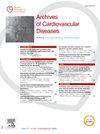帕罗西汀抑制GRK2可预防间歇性缺氧引起的缺血性心肌病恶化
IF 2.3
3区 医学
Q2 CARDIAC & CARDIOVASCULAR SYSTEMS
引用次数: 0
摘要
梗阻性睡眠呼吸暂停(OSA)患者在心肌梗死(MI)后预后较差。间歇性缺氧(IH)是OSA的标志性特征,可促进交感神经亢进和全身胰岛素抵抗,并已被确定为心肌梗死后心脏重构和收缩功能障碍的主要因素。目的:我们假设IH诱导的交感神经过度活跃和代谢改变通过激活G蛋白偶联受体激酶(GRK2)参与缺血性心肌病的加重,已知GRK2参与肾上腺素能脱敏。为了研究GRK2的有害作用,我们使用了帕罗西汀,一种特定的GRK2抑制剂。方法永久性结扎C57bl6小鼠左冠状动脉诱导心肌梗死。然后将小鼠随机分为IH (21-5% FiO2, 60 s周期,8 h/天)或常氧(N)组,持续6周。暴露两周后,小鼠接受GRK2抑制剂帕罗西汀(5mg /kg/d)或25% DMSO (Alzet®泵)治疗。小鼠的纵向随访包括评估交感神经活动(心率变异性谱分析(HRV)),全身胰岛素敏感性(动态胰岛素耐量试验)和心功能/重构测定(超声心动图)。在方案结束时,通过RT-qPCR和组织学(天狼星红和WGA染色)评估心脏间质纤维化和肥大。在注射NaCl或胰岛素(0,5 UI/kg) 15 min后,用Western blot方法评估胰岛素信号通路。结果与N组相比,IH组心肌梗死后收缩功能障碍(即射血分数)加重,而帕罗西汀治疗可预防心肌梗死后收缩功能障碍。虽然IH不诱导心肌细胞肥大,但它会导致心脏间质纤维化和细胞凋亡增加,这是由帕罗西汀限制的。我们的研究结果证明了ih诱导的心肌梗死小鼠交感神经过度活动[即LF(低频)增加,来源于HRV分析]。帕罗西汀可消除MI-IH条件下的LF升高,恢复β1和β2肾上腺素能受体mRNA的表达。最后,与MI-N相比,IH诱导心肌梗死后全身胰岛素抵抗,而帕罗西汀可以预防这种情况。帕罗西汀的这种有益作用可能是通过改善MI-IH小鼠肝脏和肌肉中的胰岛素信号传导(pIRβ &;pAKT)。结论帕罗西汀抑制GRK2可通过抑制心脏交感神经亢进和全身胰岛素抵抗来限制ih诱导的缺血性心肌病恶化。本文章由计算机程序翻译,如有差异,请以英文原文为准。
GRK2 inhibition by paroxetine prevents intermittent hypoxia-induced worsening of ischemic cardiomyopathy
Introduction
Patients with obstructive sleep apnea (OSA) exhibit poor prognosis after myocardial infarction (MI). Intermittent hypoxia (IH), the hallmark feature of OSA, promotes sympathetic hyperactivity and systemic insulin resistance, and has been identified as a major contributor to post-MI cardiac remodeling and contractile dysfunction.
Objective
We hypothesize that sympathetic hyperactivity and metabolic alterations induced by IH participate in the aggravation of ischemic cardiomyopathy via activation of G protein-coupled receptors kinase (GRK2), known to be involved in adrenergic desensitization. To investigate the detrimental role of GRK2, we used paroxetine, described as a specific GRK2 inhibitor.
Method
MI is induced in C57bl6 mice by permanent ligation of the left coronary artery. Mice are then randomized to IH (21–5% FiO2, 60 s cycle, 8 h/day) or normoxia (N) for up to 6 weeks. After two weeks exposure, mice are treated with a GRK2 inhibitor, paroxetine (5 mg/kg/d), or 25% DMSO (Alzet® pumps). Longitudinal follow-up of mice includes evaluation of sympathetic activity (spectral analysis of heart rate variability (HRV), systemic insulin sensitivity (dynamic insulin tolerance test) and determination of cardiac function/remodeling (echocardiography). At the end of the protocol, cardiac interstitial fibrosis and hypertrophy are evaluated by RT-qPCR and histology (Sirius Red and WGA staining). Assessment of insulin signaling pathway is performed by Western blot 15 min after injection of NaCl or insulin (0,5 UI/kg).
Results
Compared to N condition, IH worsens post-MI contractile dysfunction (i.e. ejection fraction), which is prevented by paroxetine treatment. Whereas IH does not induce cardiomyocyte hypertrophy, it results in increased cardiac interstitial fibrosis and apoptosis, which are limited by paroxetine. Our results evidence an IH-induced sympathetic overactivity in MI mice [i.e. increase in LF (Low Frequencies), derived from HRV analysis]. Paroxetine abolishes the increase in LF in MI-IH condition and restores mRNA expression of β1 and β2 adrenergic receptors. Finally, IH induces post-MI systemic insulin resistance compared to MI-N condition, which is prevented by paroxetine. This beneficial effect of paroxetine could result from improvement of insulin signaling in liver and muscle of MI-IH mice (pIRβ & pAKT).
Conclusion
Inhibition of GRK2 by paroxetine limits IH-induced worsening of ischemic cardiomyopathy, by limiting both cardiac sympathetic hyperactivity and systemic insulin resistance.
求助全文
通过发布文献求助,成功后即可免费获取论文全文。
去求助
来源期刊

Archives of Cardiovascular Diseases
医学-心血管系统
CiteScore
4.40
自引率
6.70%
发文量
87
审稿时长
34 days
期刊介绍:
The Journal publishes original peer-reviewed clinical and research articles, epidemiological studies, new methodological clinical approaches, review articles and editorials. Topics covered include coronary artery and valve diseases, interventional and pediatric cardiology, cardiovascular surgery, cardiomyopathy and heart failure, arrhythmias and stimulation, cardiovascular imaging, vascular medicine and hypertension, epidemiology and risk factors, and large multicenter studies. Archives of Cardiovascular Diseases also publishes abstracts of papers presented at the annual sessions of the Journées Européennes de la Société Française de Cardiologie and the guidelines edited by the French Society of Cardiology.
 求助内容:
求助内容: 应助结果提醒方式:
应助结果提醒方式:


